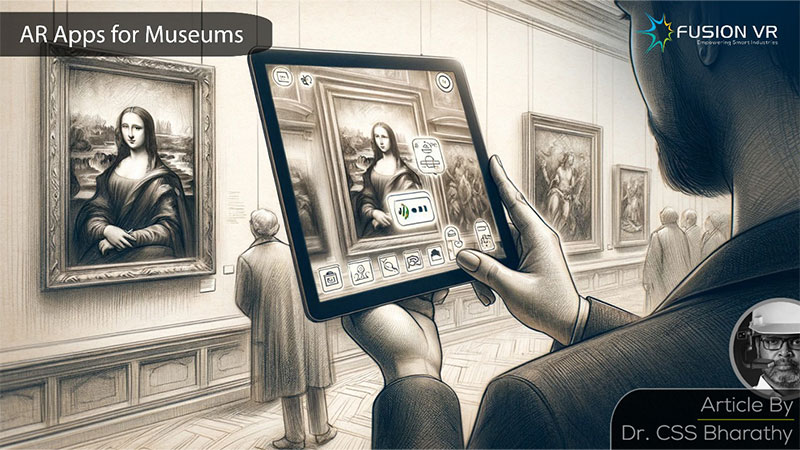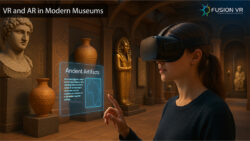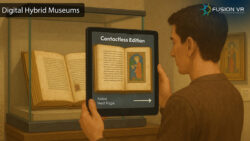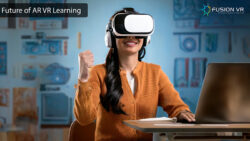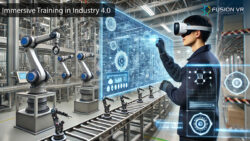The world of augmented reality applications has influenced various areas of human activity, from business, manufacturing, to education and gaming. Think of anything, and you may find something that involves augmented reality. The world of museums is not left behind and the recent shift from traditional museums to interactive museums has embraced augmented reality solutions completely. Augmented reality has turned out to be one of the most effective technologies that museums need to bring in visitors with highly interactive experiences and exhibits. So what are the top applications of AR in museums? Let’s find out.
For the uninitiated, Augmented Reality of AR as it is commonly known, is a cool technology that enables the overlay of digital content over the reality we can see through our digital devices and wearables. In simple terms, augmented reality provides something relevant and interesting to see over and above what you would see through your smartphone camera. Imagine you are walking the streets of Chennai and you need directions to go to the Amma Museum on Marina Beach. You get dropped off somewhere close to the beach and you are unable to decide whether to proceed towards your right or left to get there. So you flip out your smartphone, which opens up a map app and provides you with the much-needed directions. What an AR feature allows you to do is, activate the camera, opening up the street in front of you and providing visual cues and voice-over directions to get there. It has just “augmented” the reality you see with relevant and contextual information to assist you in your effort to get to the museum. Now this is a very simple example of the use of augmented reality we can use in our daily life and is just to illustrate how AR works.
Augmented reality has many applications, particularly in today’s museums. Almost all new museums and many older museums are transitioning to what we refer to as Museum 2.0. This is probably a new term for many, but it represents the next generation of museums which incorporate many of the latest digital technologies to develop and commission interactive and immersive exhibits, experiences and deliver unique value propositions within the physical realm of a museum. These innovative concepts, approaches and strategies are designed to drive greater visitor arrivals, participation and enable complete engagement across the entire visitor spectrum. The goal of Museum 2.0 is to deliver enriching and unforgettable experiences and educational value for all museum patrons.
One of the top AR applications is to make static exhibits in museums deliver an interactive experience. Most museums have valuable artifacts displayed with glass or more secure enclosures. This mostly 2D view steals away the opportunity to learn more about the value and significance of the artifact. Imagine if the artifact comes alive, digitally albeit to talk about itself in an augmented reality museum experience. Or have its creator appear beside the artifact to explain its features, provenance and its arrival in the museum? This is made possible by an expertly designed AR application that can be loaded onto your smartphone or tablet. Museums could also provide such devices on loan with the application preloaded in it. It would also come with a headphone that would enable you to receive and enjoy audio inputs, prompts and content.
The content appropriate to the artifact is launched on your device by scanning a QR code beside the artifact and you would be able to now see digital information that points out the amazing features of the artifact via text, animation or voice. The visitor gets immediate information about it and gets interested to learn more about it. The app could launch a highly realistic 3D model or a hologram of the same artifact which allows you to look at it from all sides. This is far better and more revealing than a 2D version of it. The voice description of the artifact could be from an expert attached to the museum or a researcher who knows more about the subject matter. The information is original, authentic and informative, greatly augmenting the visitor’s experience.
The application could also take you back in time and provide more information on how this artifact was in its original form and environment. If the artifact has been damaged as it passed hands, a digital recreation of the original artifact shows it in all completeness. This experience is only possible with the expert application of augmented reality technology along with the expertise of historians, curators, engineers, artists and application developers. This application can be extended to all artifacts, paintings and other cultural, scientific and technological objects of historical interest. The overall benefit is for the visitors to get engaged, experience and learn about historical things that are valuable to a nation. This AR application is viewed as a great tool to easily enable people to learn and experience the things that matter to their society and nation.
Another top AR application is to recreate an environment that is not easily accessible, say a rainforest in the remote parts of the island of Borneo. How does one experience at least some of the magic that can be experienced in a rainforest? What kinds of flora and fauna are there? Why are they important to the survival of humanity and the planet? These are questions that many would have. The exhibit that recreates a specific environment uses complex projection screens and sound systems that provide a feel of the sights, sounds and even smells. The AR application is designed to display content on the various aspects of the rainforest. The application is launched as you enter the exhibit and you begin to see the hidden inhabitants of the rainforest emerge through your digital device or wearable. As a visitor, you begin the experience of the immersiveness brought about by the application. This is truly magical and creates a unique awareness and appreciation of the rainforest. You could see and learn more about the endangered plants and animals and ponder about what could be your contributions to preserve them. This awareness and thinking is vital to the aims and objectives of the museum and conservation groups. AR technology in museums helps to influence through the development of unique interactive and immersive experiences. Similar experiences can be developed depending on the areas of focus desired by the museum. Such experiences deliver valuable education outside the four walls of a classroom.
Another top AR application is that it enables the visitor to view personalities and their activities through the use of AR holograms. The visitor may be able to see how astronauts moved and worked inside their spacecraft as they view the actual object or a replica of it in a specially created augmented reality experience center. This has a lot of educational value and a deeper understanding of how things were actually done. The retention of what was seen is very high and could help students understand concepts and applications more thoroughly and help them gain academic mastery and competencies. These experiences lay the foundation for developing interest and academic pathways for young students through the expert use of such technologies in museums.
What we have shared here is just the tip of the iceberg on AR applications for museums. There is much more available and more to come in the near future as they are developed. The development of such exhibits and experiences is a collaborative effort of many disciplines and personnel. The technological and project capabilities are delivered by expert Museum 2.0 solution providers like Fusion VR in India. There are many examples of interactive museums like the Amma Museum and Knowledge Park in Chennai, RKM Museums at various locations in India and most recently the Kalaignar Museum, also in Chennai. These showcase our expertise and we encourage you to reach out to us when you have plans to establish augmented reality exhibits and experiences. More details can be found at our dedicated website on Museum 2.0 and we would be more than happy to partner with you in your efforts.

